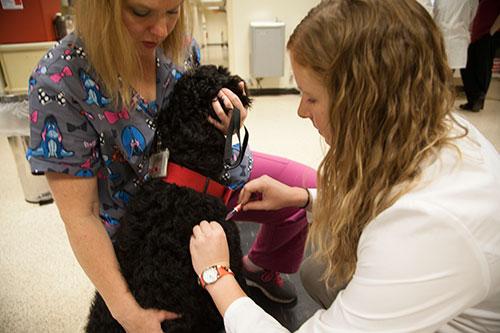
Rabies and Pets
Thursday, September 14, 2017
Rabies is a deadly, yet preventable disease in pets. Vaccination is key to preventing rabies. Here is some important rabies information from the American Veterinary Medical Association.
Rabies is caused by a virus that attacks the nervous system. The virus is secreted in saliva and is usually transmitted to people and animals by a bite from an infected or rabid animal. Humans can also be infected when saliva from a rabid animal comes in contact with the membranes of the eyes, nose, or mouth of person or animal or an open cut on the skin.
Animals with rabies may show a variety of signs including fearfulness, aggression, excessive drooling, and staggering to name a few.
Horses and livestock with rabies may exhibit depression or increased sensitivity to light. Rabid wild animals may lose their natural fear of humans and an animal typically seen at night may be seen wandering in the daytime.
Rabies should be considered in all cases of unexplained neurological disease. There is no treatment for rabies once the clinical signs appear.
Rabies is nearly always fatal. Rabies infection of an animal can only be confirmed after death, through microscopic examination of the animal’s brain.
All mammals are susceptible to rabies. Birds, fish, reptiles and amphibians do not get rabies. In the United States, most cases occur in wild animals—skunks, raccoons, bats, coyotes and foxes.
In recent years, cats have become the most common domestic animal infected with rabies. This is because many cat owners do not vaccinate their cats and cats can be exposed to rabid wildlife—either outdoors or when bats get into the house.
Vaccination programs and control of stray animals have been effective in preventing rabies in most pets. Approved vaccines are available for cats, dogs, ferrets, horses, cattle and sheep.
Most of the U.S. cases have resulted from human exposures to bats. Any contact with bats, even if no bite is noticed, should be reported to your physician. Bat-proof your home or other buildings to reduce exposure.
Reduce the possibility of exposure to rabies by not letting your pets roam free. Keep cats and ferrets indoors and supervise dogs when they are outside.
Do not leave exposed garbage or pet food outside as it may attract wild or stray animals.
Never keep wild animals as pets. Not only may this be illegal, but wild animals pose a potential rabies threat to caretakers and others.
If you see a wild animal acting strangely, report it to the city or county animal control department.
If your pet is bitten, consult your veterinarian immediately and report the bite to local animal control authorities.
The most important thing to remember about rabies is that it IS preventable. Vaccinate your pets. Consult your veterinarian for the appropriate vaccination and frequency schedule.
by Elisabeth J. Giedt, DVM
Veterinary Viewpoints is provided by the faculty of the OSU Veterinary Medical Hospital. Certified by the American Animal Hospital Association, the hospital is open to the public providing routine and specialized care for all species and 24-hour emergency care, 365 days a year.
